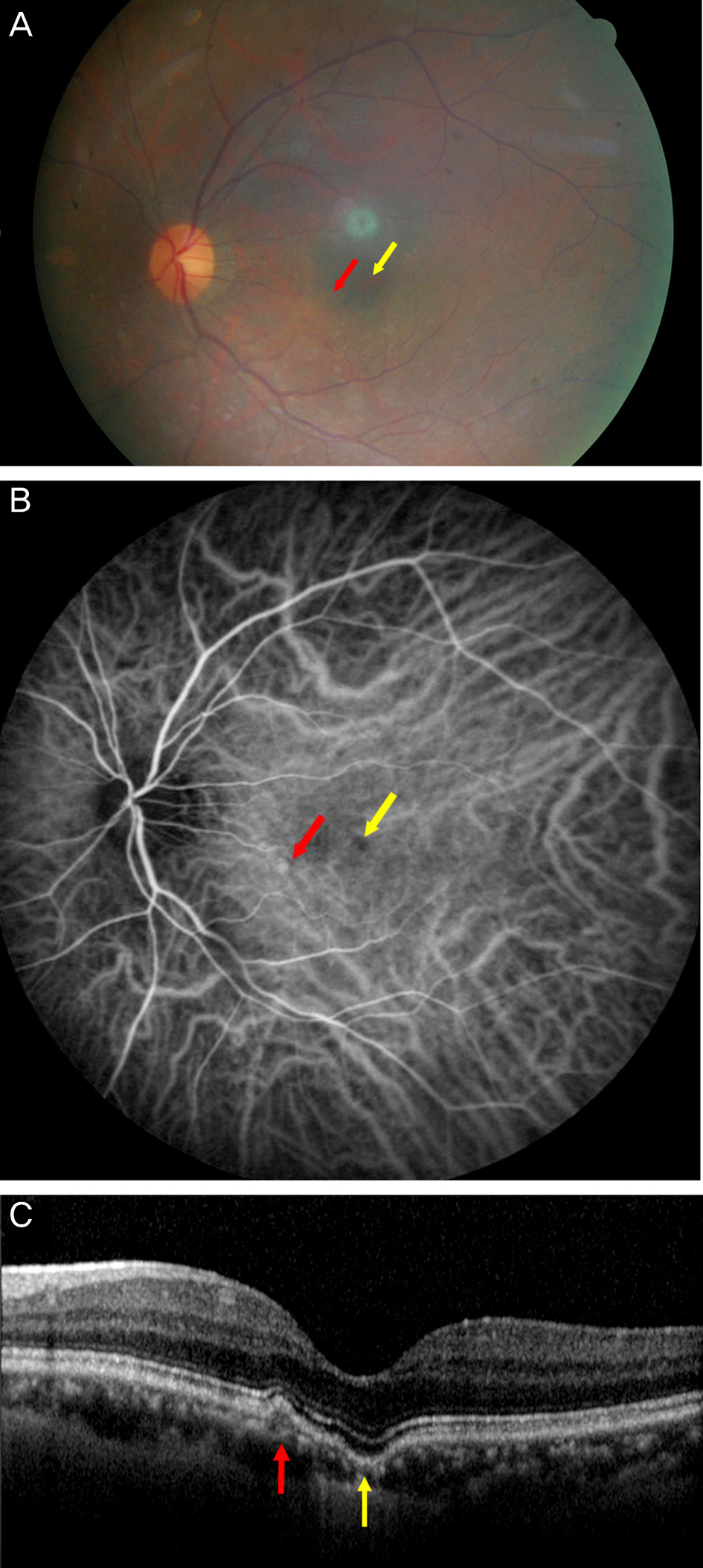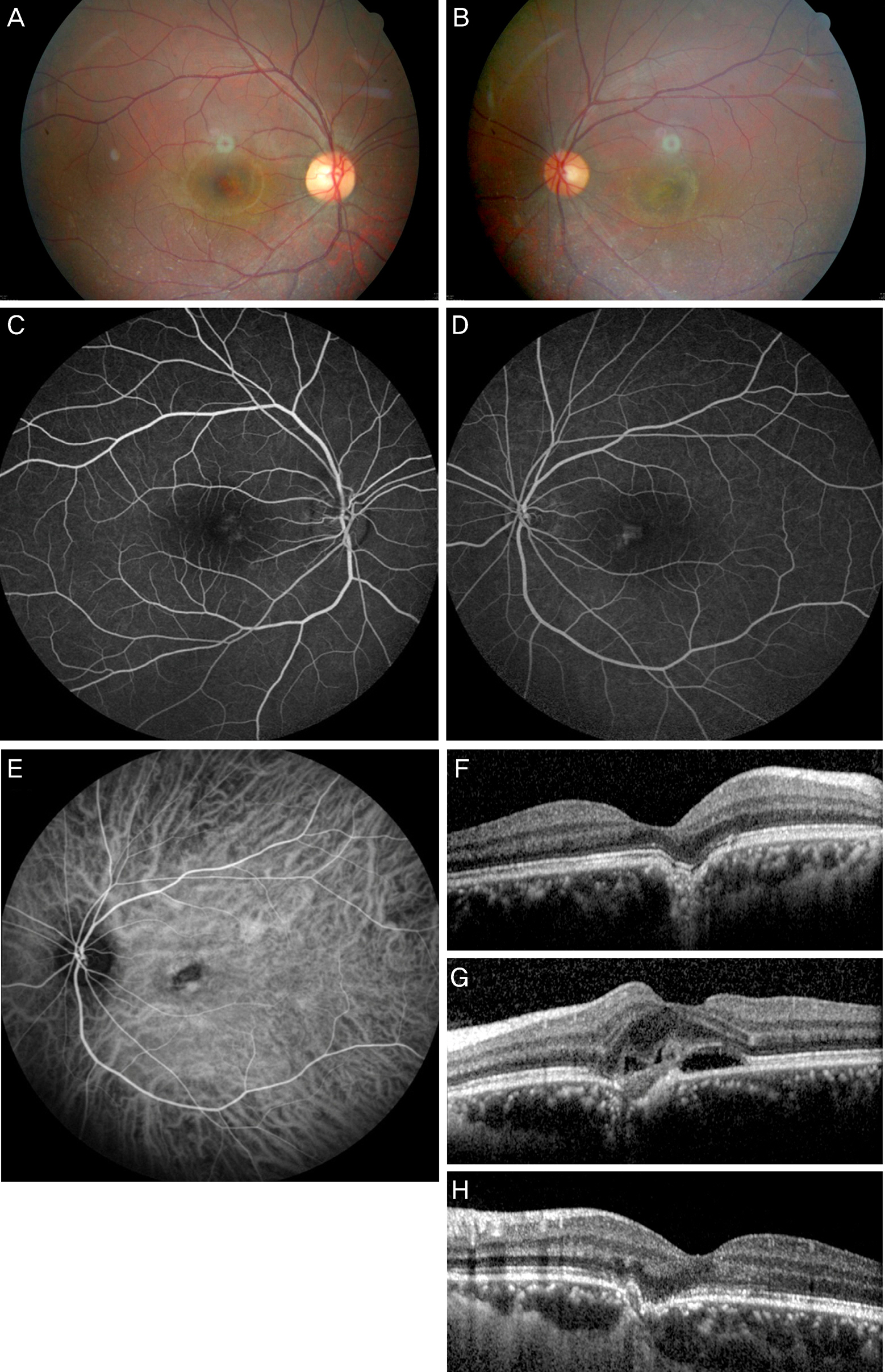J Korean Ophthalmol Soc.
2014 Jun;55(6):941-946.
Three Cases of Focal Choroidal Excavation in the Macula Detected by Spectral-Domain Optical Coherence Tomography
- Affiliations
-
- 1Department of Ophthalmology, Yeungnam University College of Medicine, Daegu, Korea. changwh@ynu.ac.kr
Abstract
- PURPOSE
To report the clinical finding of 3 patients with focal choroidal excavation in the macula detected by spectral-domain optical coherence tomography (SD-OCT).
CASE SUMMARY
Five eyes of 3 patients with focal choroidal excavation detected by SD-OCT were enrolled in the present study. All patients had myopia (average refractive power -5.60 diopter). Two of the 3 patients had focal choroidal excavation in both eyes. All 5 eyes revealed foveal pigmentary changes on fundus examination. The excavation area in the autofluorescence image was hypofluorescent. Fluorescein angiographic finding was normal to various degrees of hyperfluoresence. Indocyanine green angiography revealed hypofluoresence at the excavation area. The excavation involoved from the retinal pigment epithelium layer to the external limiting membrane or outer nuclear layer and average choroidal thickness at excavation were statistically thinner than the uninvolved area based on SD-OCT (p = 0.002). Retinoschisis, serous pigment epithelial detachment and choroidal neovascularziation (CNV) were detected individually in 3 eyes. The other 2 eyes had no specific abnormalities.
CONCLUSIONS
During the follow-up period, the choroidal excavation remained relatively stable in 4 of 5 eyes, but CNV developed in 1 eye. Therefore, intravitreal bevacizumab injection was performed. Longer follow-up periods are necessary to determine the etiology, clinical course and visual prognosis of eyes with focal choroidal excavation.
Keyword
MeSH Terms
Figure
Reference
-
References
1. Jampol LM, Shankle J, Schroeder R, et al. Diagnostic and ther-apeutic challenges. Retina. 2006; 26:1072–6.
Article2. Wakabayashi Y, Nishimura A, Higashide T, et al. Unilateral choroi-dal excavation in the macula detected by spectral-domain optical coherence tomography. Acta Ophthalmol. 2010; 88:e87–91.
Article3. Margolis R, Mukkamala SK, Jampol LM, et al. The expanded spectrum of focal choroidal excavation. Arch Ophthalmol. 2011; 129:1320–5.
Article4. Kobayashi W, Abe T, Tamai H, Nakazawa T. Choroidal excavation with polypoidal choroidal vasculopathy: a case report. Clin Ophthalmol. 2012; 6:1373–6.
Article5. Katome T, Mitamura Y, Hotta F, et al. Two cases of focal choroidal excavation detected by spectral-domain optical coherence tomography. Case Rep Ophthalmol. 2012; 3:96–103.
Article
- Full Text Links
- Actions
-
Cited
- CITED
-
- Close
- Share
- Similar articles
-
- A Case of Focal Choroidal Excavation Associated with Chronic Central Serous Chorioretinopathy
- Choroidal Thickness at the Outside of Fovea in Diabetic Retinopathy Using Spectral-Domain Optical Coherence Tomography
- A Case of Ocular Toxoplasmosis Imaged with Spectral Domain Optical Coherence Tomography
- Availability of Optical Coherence Tomography in Diagnosis and Classification of Choroidal Neovascularization
- Choroidal Thickness in Primary Open-Angle Glaucoma Using Spectral-Domain Optical Coherence Tomography




